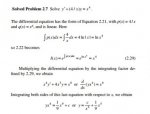Marian
New member
- Joined
- Jan 16, 2015
- Messages
- 3
Hello, everyone,
this is my first time posting something here. I hope this is not too simple.
I'm studying the book: Schawm's Easy Outlines in Differential Equations [link].
I'm trying to understand a solved problem. This is: page 18, problem 2.7
Probably it is just a notation problem, but I'm not sure.
My question is what happens with the second term (4yx^3) when the expression is written in Leibniz form:

Something similar happens in the problem 2.8

The complete problems:
Problem 2.7

Problem 2.8

Thank you very much. If there is anything unclear, please tell me.
Best,
Marian
this is my first time posting something here. I hope this is not too simple.
I'm studying the book: Schawm's Easy Outlines in Differential Equations [link].
I'm trying to understand a solved problem. This is: page 18, problem 2.7
Probably it is just a notation problem, but I'm not sure.
My question is what happens with the second term (4yx^3) when the expression is written in Leibniz form:
Something similar happens in the problem 2.8
The complete problems:
Problem 2.7

Problem 2.8

Thank you very much. If there is anything unclear, please tell me.
Best,
Marian
Last edited:

